Creating and Modifying Website Filtering Rules
The 'Rules' tab allows you to create, view, edit and specify exceptions to your website filtering rules. The powerful rule-configuration interface lets you create rules which are as sweeping or as granular as you require. Rules can be created on a per-user basis, allowing you to control exactly which websites certain people can or cannot visit. You can also disable or enable a rule as required at any time.
Comodo Firewall implements rules for the currently logged-in user based on the order they are in this list. Should a conflict exist between individual rules, then the rules at the top takes priority. Click the handle and use the 'Move Up' or 'Move Down' buttons to change a rule's priority.
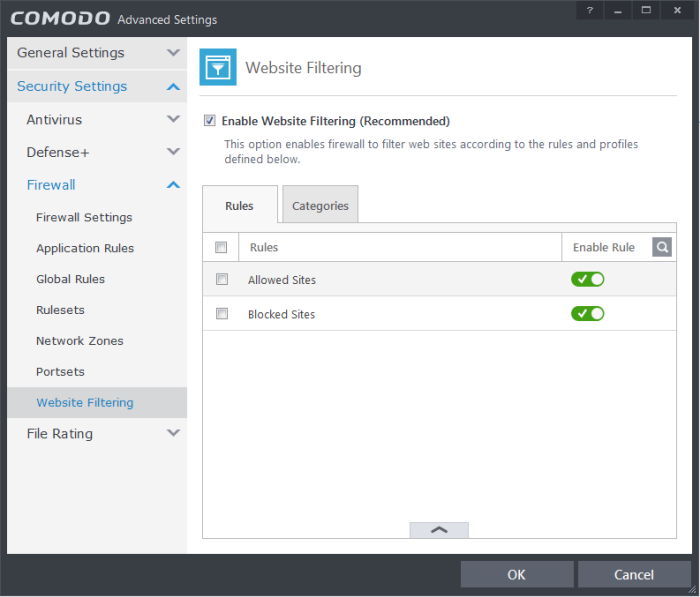
- The switches in the 'Enable Rule' column enable you to quickly turn a rule on or off
- The check-boxes next to a rule name allow you to select it for editing, removing or re-prioritizing using the controls at the bottom of the interface:

You can search for a specific rule by clicking the search icon ![]() at the far right in the column header.
at the far right in the column header.

- Enter full or part of the name of the rule in the search field.
- Click the right or left arrow at the far right to begin the search.
-
Click the
 icon in the search field to close the search option.
icon in the search field to close the search option.
The Rules interface allows you to:
To create a new Website filtering rule
1. Open the 'Website Filtering' Panel by clicking 'Security Settings' > 'Firewall' > 'Website Filtering' from the 'Advanced Settings' interface2. Click the handle at the bottom of the Rules interface and select 'Add':
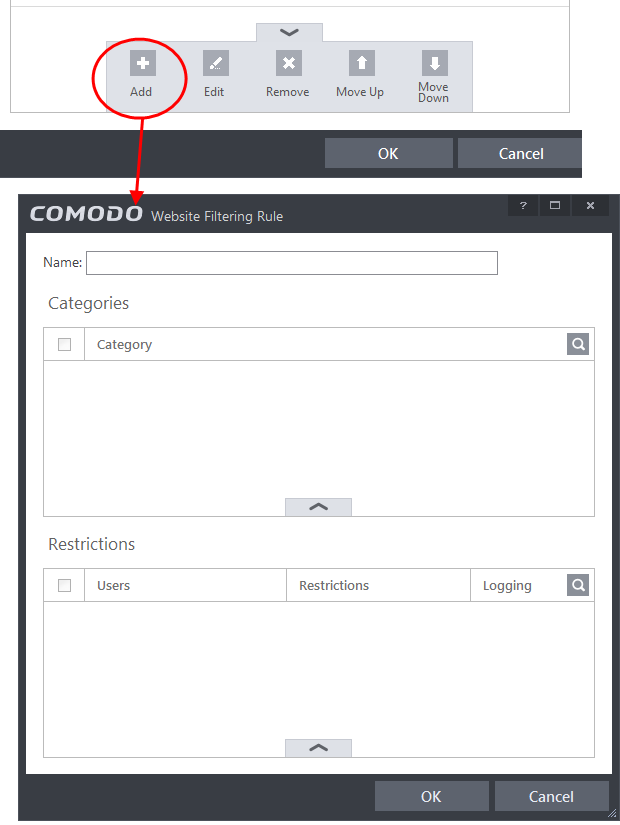
4. Select the categories that should be added to the filter:
- Click the handle at the bottom of the 'Category' pane and choose 'Add'.

Select a category and click 'OK' to add it to your rule. Repeat the process to add more categories.
The 'categories' window contains a list pre-defined Comodo categories and any user created categories. Comodo categories cannot be modified.
For more details on creating and modifying user specified categories, Refer to the section Defining or Modifying Website Categories
- Comodo Safe Category - URLs of websites that are considered safe according to global whitelist
- Comodo Phishing Category - URLs of websites that lead to phishing websites, as per dynamically updated Comodo Blacklist
- Comodo Malware Category - URLs of websites that may inject malware into your system, as per dynamically updated Comodo Blacklist
- Select the category to be included in the filter and click OK.
- Repeat the procedure to add more categories.
- To remove an unwanted category, select it, click the handle from the bottom and click 'Remove' from the options
- Click the handle at the bottom of the 'Restrictions' pane and click 'Add'. The 'Select User or Group' dialog will appear:
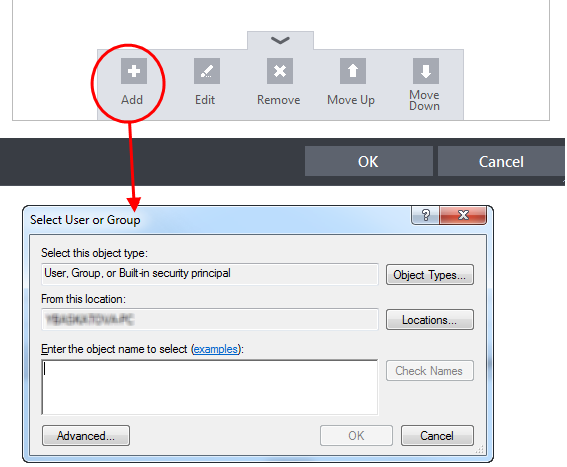
- Enter the names of the users to whom the filter is to be applied in the 'Enter the object name to select' text box with the format or @. Alternatively, click 'Advanced' then 'Find Now' to locate specific users. Click 'OK' to confirm the addition of the users.
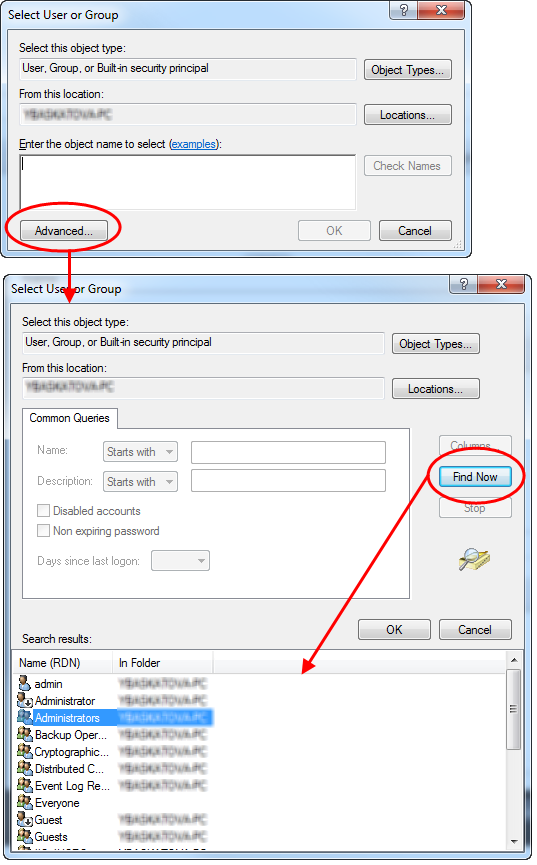
After adding target users or groups, you next need to specify whether those users should be allowed or blocked from viewing the websites in the category or they should be asked if they want to continue. This is done by modifying the link in the 'Restrictions' column:
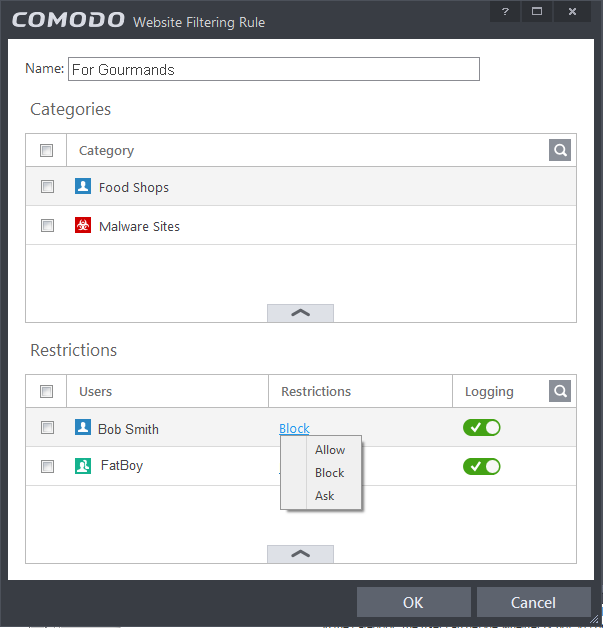
- Allow - The websites in the categories can be accessed by the user.
- Block - The websites in the categories cannot be accessed by the user.
- Ask - An alert will be displayed in the browser (shown below) if the user tries to access any of the websites in the category. The user can decide whether or not to continue.

6. Use the 'Logging' switch to choose whether or not attempts to access a categorized website are logged.
7. Click 'OK' to save your new rule. The new rule will be added to the list of rules under the 'Rules' tab
8. Make sure that the rule is enabled using the toggle switch under the Enable Rule column for the rule to take effect.
- You can disable or enable rules at any time using the switch under the 'Enable Rule' column.
Important Note to Windows 8 and Windows 8.1 users: If you are using Internet Explorer 11 version 11.0.9600.16384, it is mandatory to add the user group 'ALL APPLICATION PACKAGES' to the Restrictions list in addition to the intended users for each rule you create.
If you or other users access websites using Internet Explorer 11 on Windows 8/8.1, then you must add this user group or your rules will have no effect. For example, users will still be able to access blocked websites.
To add 'ALL APPLICATION PACKAGES' to the restrictions list
- Click 'Advanced' in the 'Select User or Group' dialog

- Click 'Find Now' and select 'ALL APPLICATION PACKAGES' from the list of users and groups displayed in the list at the bottom
- Click OK

To edit existing rules
2. Choose the Website Filtering Rule to be edited under the 'Rules' tab by selecting the checkbox beside the rule.
3. Click the handle from the bottom center of the Rules interface and choose 'Edit' from the options.
The ' Website Filtering Rule' interface for the selected rule will open. You can add/remove categories, add/remove users or change the restriction for selected users from this interface. Refer to To create a new Website Filtering Rule for more details on this interface.
To remove a Website Filtering Rule
1. Open the ' Website Filtering' Panel by clicking 'Security Settings' > 'Firewall' > 'Website Filtering' tab from the 'Advanced Settings' interface
2. Choose the Website Filtering Rule(s) to be removed under the 'Rules' tab by selecting the checkbox(es) beside them.
3. Click the handle from the bottom center of the Rules interface and choose 'Remove' from the options.
To change the priority of Website Filtering Rules
1. Open the ' Website Filtering' Panel by clicking 'Security Settings' > 'Firewall' > 'Website Filtering' tab from the 'Advanced Settings' interface
2. Choose the Website Filtering Rule to be moved under the 'Rules' tab by selecting the checkbox beside the rule.
3. Click the handle from the bottom center of the Rules interface and choose 'Move Up' or 'Move Down' option to change the order of the rules in the interface.



